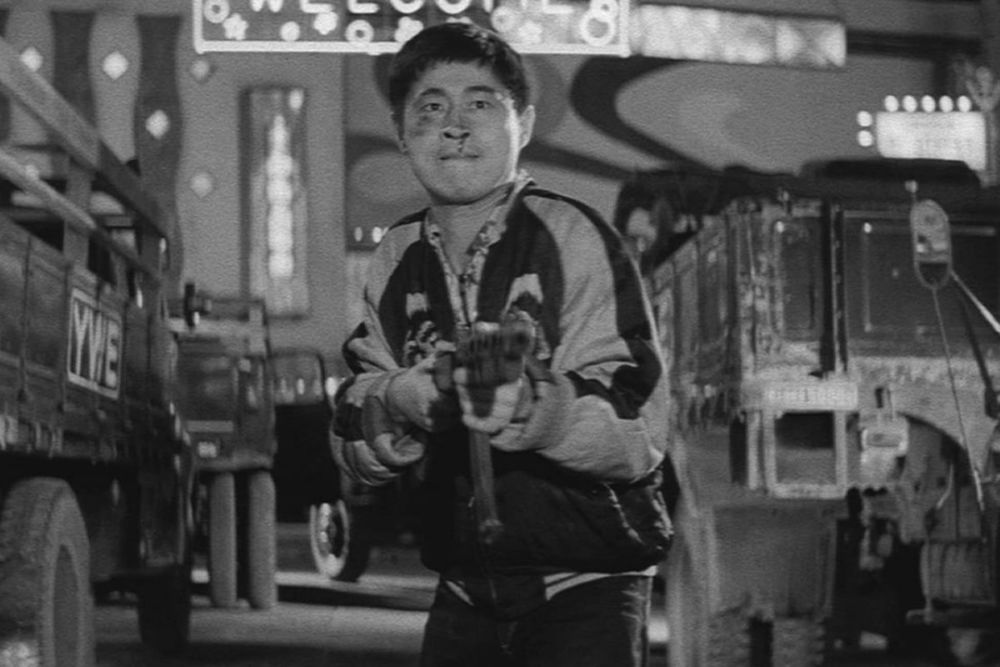
Since its rise as a fashion trend in the 2010s and onward, the sukajan jacket has been sported by the likes of Ryan Gosling, Harry Styles, Katy Perry and Kanye West and featured on the catwalks of Dior, Louis Vuitton and Yves Saint Laurent. But, likely unbeknownst to its many wearers, the sukajan travelled a complicated path from military-occupied Japan in World War II before becoming one of the most-seen fashion items around the globe.
Military chic has always been hip, but its tactical origins are often glossed over. For instance, the trench coat emerged from a design submitted to the United Kingdom War Office in 1901. Aviator sunglasses were first contracted by the U.S. military in 1935. Military garb may be one of the first mass-produced ready-to-wear garments in history. But how much of the cultural richness in the styles that fashion consumers cycle through season after season, such as the sukajan, are being forgotten?
The sukajan emerged during the American Occupation of Japan after the Japanese surrender in World War II. U.S. Navy forces and soldiers occupied Yokosuka, the former base of the defeated Imperial Japanese Navy. This origin is reflected in the name of the jacket itself — Yokosuka and jyanpa (the Japanese term for “jumper” or jacket).

Image from Louis Vuitton S/S 16
Japanese tailors first embroidered sukajan for American soldiers looking for souvenirs of their tour of duty. Japanese craftsmen constructed them in the form of classic American letterman jackets featuring embroidered designs of Japanese motifs such as dragons, koi, tigers and sakura blossoms, as well as American symbols like fighter planes and eagles. The satin finish of the jacket was also a product of war; sometimes the embroidery was added to an existing flight jacket, or the jacket was made from leftover parachute silk or nylon.
The sukajan is transcultural, economic and poignantly militaristic; these were designs made by Japanese hands to be worn by foreign soldiers during a fragile post-war period in Japan. Dr. Elizabeth Kramer, a specialist in fashion and textile exchanges between Japan and Britain at Northumbria University, writes: “These souvenir jackets were produced in nearby Kiryu and Ashikaga, towns long associated with the kimono industry, which had been severely disrupted during the war and no doubt welcomed the work.” Kramer details, “Historically, the tourist market aimed at servicemen was so well developed that companies sometimes tried to get a list of individually named soldiers in advance of their arrival in order to preemptively personalize souvenirs.”

Kosho&Co. Sukajan with ‘Cherry Blossoms, Atomic Bombs & Japan Map’ (late 1940s), uncatalogued collection of TOYO Enterprise Company Ltd. (from Kramer article)
A curious relationship existed between the Japanese tailor of the sukajan and the American soldier. Commenting on the jacket above, for instance, Kramer “asked what the embroiderers would have thought in stitching the starbursts above Nagasaki and Hiroshima. The grave reply suggested that economic necessity overruled sentiment in the desperate postwar climate.”
As the world entered the turbulent 1960s and with the new American war in Vietnam, wearing the sukajan took on additional associations of nonconformity and even criminality. Vietnamese war veterans in the United States began wearing “uniforms and camouflage as an act of protest against the conflict." The local blue-collar teens of Yokosuka began to buy up stores targeting American GIs, which solidified the sukajan’s association with the yakuza and juvenile delinquency in Japan.

Image from Criterion Collection (via website)
In the mid-2010s, the sukajan spiked in popularity among high fashion retailers and Hollywood celebrities. Today, sukajan are still valued for their “one-of-a-kind” nature, military chic and subversive message. As Kramer argues, it is this precise “cool” factor that makes the current design and promotion of reproduction souvenir jackets so attractive. She notes that:
“Fashion blogs … often emphasize the individuality expressed by American soldiers in selecting their jackets, rather than the essential role of Japanese producers in identifying and catering to this market. I suppose that this is probably because the fashion blogs are supporting the 2010s fashion trend, where the jacket's ability to express the individuality of its wearer is stressed and coolness given the military connection emphasised.”
Sukajan is just one example of a phenomenon that Kramer deems “new vintage.” New vintage is fashion production and consumption whose purpose and appeal is based in its nostalgic link to fashion eras past, finding its value through a promise of authenticity in the age of mass production.
The fast fashion industry capitalizes on the longing for authenticity by producing cheap, fake vintage items that encapsulate the very hollowness of mass production consumers seeking the vintage feel are trying to get away from. What this means is that while couture houses, which tend to operate more like an art gallery, are more likely to pay homage to the history and cultural inspirations behind their pieces, fast fashion does not. In an interview, Filipino American fashion designer Sam Ibanez says, “Many offensive pieces that do not credit original designers do go through in fast fashion, but that is not so common in the Maisons [such as Chanel and Louis Vuitton]. The big ones do it right.”
In this tension, sukajan’s susceptibility to cheap reproduction is easy to imagine. A quick internet search brings up a site selling a sukajan-style jacket going for $22.26. Slightly higher priced is the Zara reproduction selling at $97.00 on eBay. While authentic vintage jackets easily sell in the upper hundreds, “new vintage” copycats are successful in finding a niche among consumers craving authenticity on a budget.

On the one hand, streetstyle anthropologist Ted Polhemus emphasizes that in contemporary times, the street has toppled the upper-class monopoly on fashion. We, the Urban Outfitter stans, vintage shop lurkers, hip-Aunt-from-the-’70s-hand-me-down wearers, own the social and cultural power to create culture. Fashion of the streets, worn on bodies sauntering down the aisles of Trader Joe’s, posing against the handrail of subway cars, sunbathing in public parks, are the authentic commodities that high fashion imitates — not the other way around. “We are all breaking rules — mixing sportswear with workwear, the old and the new — mating the vulgar and the respectable,” Polhemus declares.
Yet on the other hand, does mass-produced street-style dilute and sanitize the history of the fashion items taken from other cultures? In the case of the popular sukajan, where would it be without the entrepreneurial spirit and craftsmanship of the original Japanese artisans? As Kramer summarizes, “the transformation of social and political action or values into branded content” — as the sukajan has become — “leads to ‘cultural irrelevance.” The sukajan displayed on the brightly colored walls or pixels of ASOS or Zara can be just another example of fast fashion’s appeal to "new vintage" — selling another military design among many, divorced of its imperialistic origins.
As the painful memories of World War II fade, it is easier to disassociate the atrocities of war from the beautiful designs rendered in silk. But should we? Recalling the power of individuals to establish trends, consumers should also remember that they always have the agency to dig into the history of a style and attempt to keep such cultural context relevant.
---
References:
1. Kramer, Elizabeth. (2020). New vintage – new history? The sukajan (souvenir jacket) and its fashionable reproduction. International Journal of Fashion Studies. 7. 25-47. 10.1386/infs_00015_1.
2. Shepherd, R. (2019, January 31). History of trench coats - not just for flashers. Retrieved March 19, 2021, from https://dieliving.com/history-of-trench-coats-not-just-for-flashers
3. Lipow, Moss. “Who Really Made Those WWII Aviator Sunglasses? Part 5 of Our Investigation.” The Eyewear Blog, 9 June 2014, theeyewearblog.com/who-really-made-those-wwii-aviator-sunglasses-part-5-of-our-investigation/.
4. MasterClass. “Ready-to-Wear Fashion Guide: Inside Look at Prêt-à-Porter - 2021.” MasterClass, MasterClass, 9 Nov. 2020, www.masterclass.com/articles/ready-to-wear-fashion-guide#:~:text=During%....
5. “Japan: A History of Souvenir Jackets (Sukajan).” Localiiz, www.localiiz.com/post/travel-culture-stories-japan-history-sukajan-souve....
6. Polhemus, Ted. STREETSTYLE. (n.d.). Retrieved March 19, 2021, from http://www.tedpolhemus.com/main_concept6%20467.html










Comments